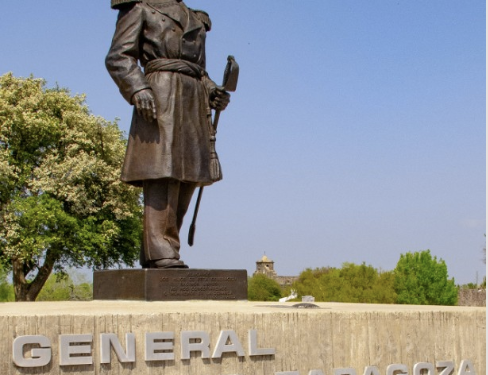GOLIAD, Texas — Picture this: It’s 1829, and the sleepy village of Goliad has been called “Goliad” for exactly a few weeks. Among the stone houses and simple jacales (that’s fancy Spanish for “huts with style”), a baby boy arrives who will grow up to give Americans everywhere an excuse to eat tacos and drink margaritas every May 5th.
Meet Ignacio Seguín Zaragoza—yes, that’s a mouthful, but stick with us—the Texas-born general who became Mexico’s biggest military hero and inadvertently launched a thousand Cinco de Mayo parties in the United States.
From Texas Tyke to Mexican Military Marvel
Little Ignacio didn’t exactly grow up destined for greatness in the traditional Texas sense. His mom was from the prominent Seguin family of San Antonio (think old Texas royalty), while his dad was a Mexican soldier from Veracruz. When Texas won its independence at San Jacinto in 1836, seven-year-old Ignacio’s family packed up and headed south to Mexico, probably thinking, “Well, this neighborhood’s gone downhill.”
The family settled in Monterrey, where young Ignacio followed in his father’s military footsteps. But this wasn’t your typical “join the army, see the world” story—Mexico in the 1850s was experiencing what historians politely call “great political upheaval,” but what was basically a really intense family feud on a national scale.
The War Nobody Talks About in History Class
During Mexico’s War of Reform, progressive liberals were duking it out with conservatives over whether Mexico should embrace democracy or stick with traditional ways. Zaragoza picked Team Liberal and served under President Benito Juarez, eventually becoming the minister of war and navy. (That’s like being both the Secretary of Defense and Secretary of the Navy, for those keeping score at home.)
Things got really interesting when Juarez essentially told European creditors, “Thanks for the loan, but we’re hitting the pause button on payments.” Spain, France, and England responded the way creditors did in the 1860s—they sent armies.
The Battle That Changed Everything (And Made Puebla Famous)
On May 5, 1862, at the city of Puebla, Zaragoza and his troops faced off against the French army in what must have been the world’s most consequential day-long battle. Against all odds, the Mexicans sent the French packing, giving President Juarez’s government a massive victory and Zaragoza a permanent place in history books.
Here’s where it gets wonderfully weird: Cinco de Mayo is celebrated in Mexico, sure, but mostly just in Puebla where the battle happened. It’s like if the Fourth of July were only celebrated in Philadelphia. Meanwhile, north of the border, Mexican American communities turned May 5th into a full-blown fiesta celebrating Mexican resilience and culture.
When Texas History Meets Mexican Legend
Today, you can visit the spot where this unlikely hero was born at the Zaragoza Birthplace State Historic Site in Goliad. The Texas Historical Commission—those wonderful folks dedicated to preserving history and helping us learn from past mistakes—created this gem in 1974.
The replica stone house, designed by architect Raiford Stripling after archaeological excavations in the late 1960s and early 1970s, perfectly captures Spanish colonial charm with its plastered walls and timbered ceilings. Inside, colorful displays tell the story of life on the early 19th-century Mexican frontier and explain how a Texas baby became Mexico’s most celebrated military hero.
The site got even more special in 1980 when the city of Puebla gifted a statue of General Zaragoza to Texas, creating a beautiful symbol of the cultural connections that transcend borders and time periods.
The Chicano Connection
Fast-forward to the 1960s, and the Chicano Movement rediscovered Cinco de Mayo as a symbol of cultural pride and resistance. What started as Mexican American communities celebrating a distant military victory became a full-blown cultural phenomenon that now involves more sombreros, mariachi music, and guacamole than Mexico ever imagined.
It’s a perfect example of how history travels, transforms, and takes on new meaning across cultures and generations. A battle in Puebla became a celebration in Los Angeles, all thanks to a kid from Goliad who probably never imagined his military service would one day justify millions of Americans’ annual pilgrimage to their local Mexican restaurant.
Why This Matters Today
The Zaragoza story perfectly illustrates how interconnected our histories really are. Here’s a guy with roots in both Texas and Mexico who made his mark in a battle that’s now celebrated more enthusiastically in the United States than in the country where it happened.
The Texas Historical Commission continues to preserve and share these complex, fascinating stories that remind us how cultures blend, influence each other, and create something entirely new. It’s not just about avoiding past mistakes—it’s about understanding how our shared histories shape who we are today.
So the next time you’re celebrating Cinco de Mayo with friends, raise a toast to Ignacio Seguín Zaragoza—the Texas-born, Mexico-serving general who proved that history is always more interesting than it appears on the surface.
And if you’re ever driving through Goliad, stop by his birthplace. It’s a small white building with a big story, standing as proof that sometimes the most unlikely people make the most lasting impact on history.
The Zaragoza Birthplace State Historic Site is located in Goliad and is open for visitors year-round. For more information about Texas Historical Commission sites and programs, visit their website or contact local visitor centers.




